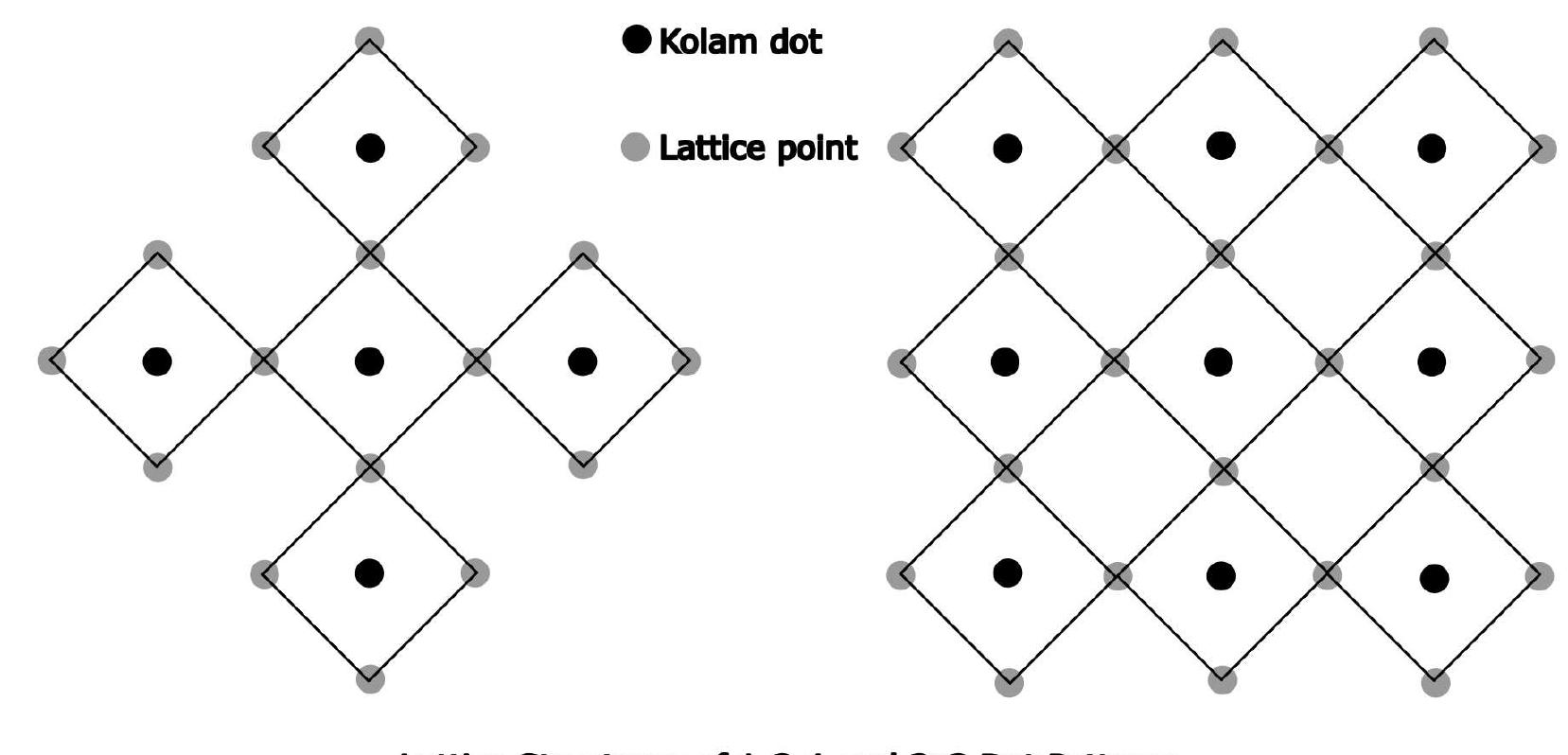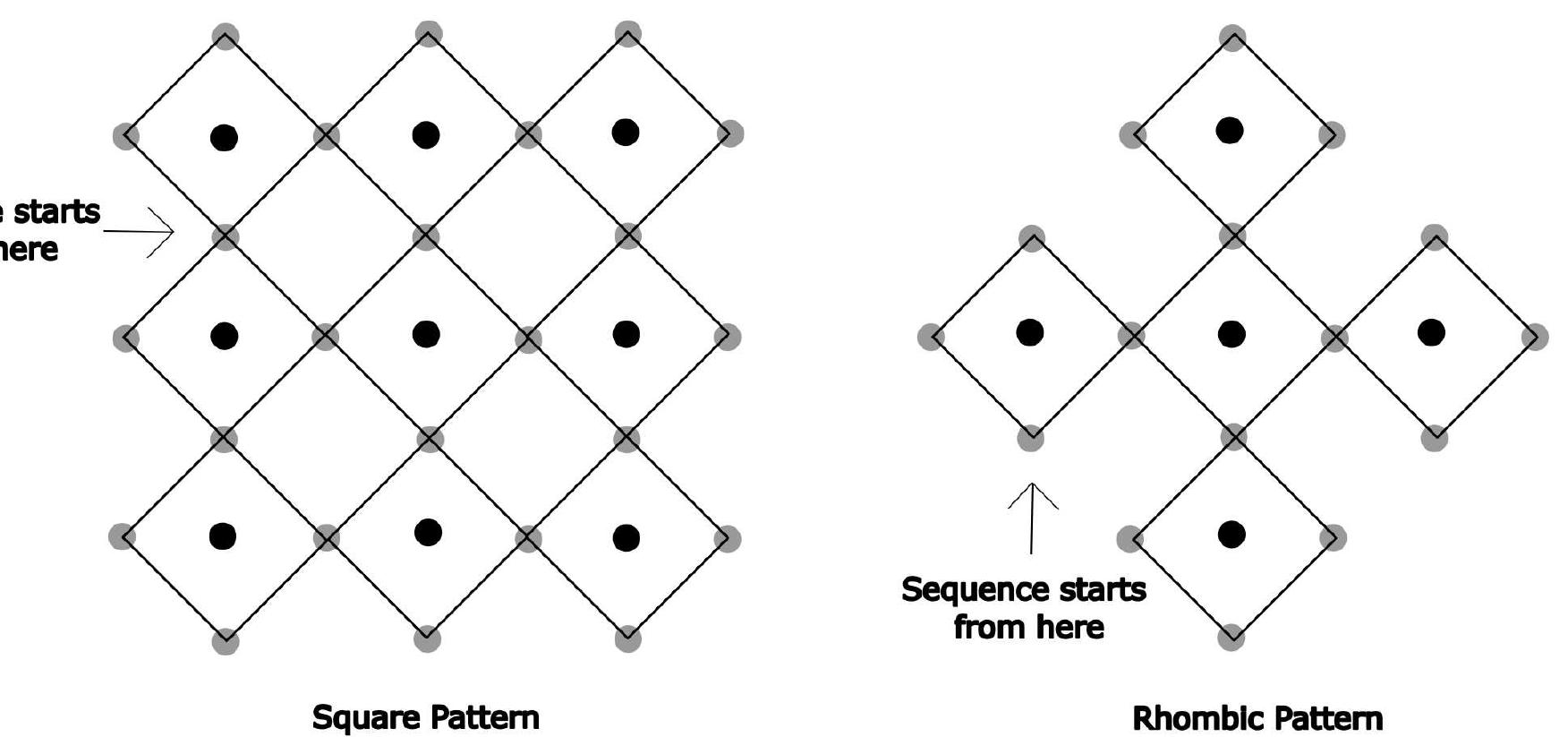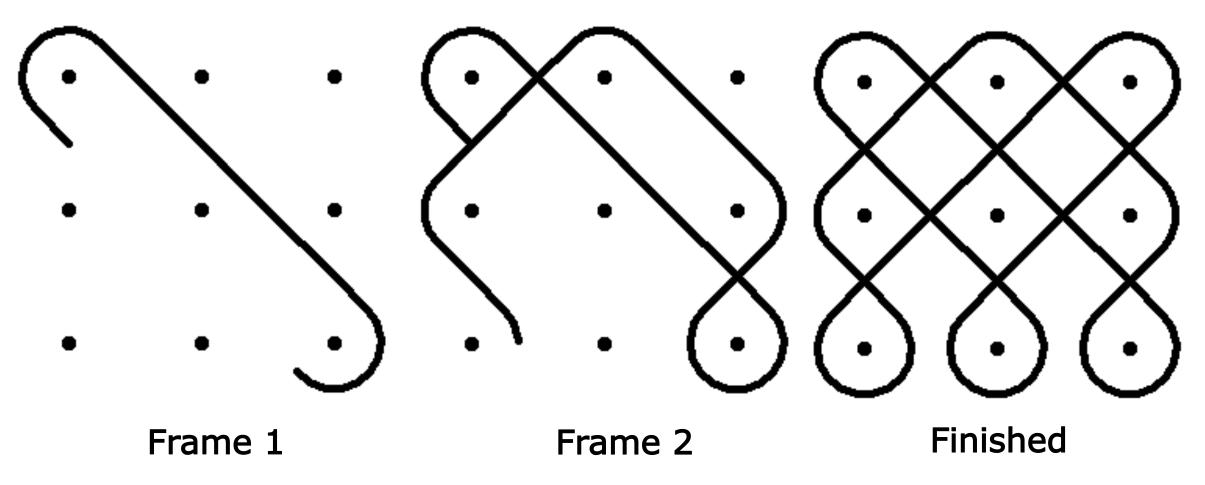Kolam Simulation using Angles at Lattice Points
2023, arXiv (Cornell University)
Sign up for access to the world's latest research
Abstract
Kolam is a ritual art form practised by people in South India and consists of rule-bound geometric patterns of dots and lines. Single loop Kolams are mathematical closed loop patterns drawn over a grid of dots and conforming to certain heuristics. In this work, we propose a novel encoding scheme where we map the angular movements of Kolam at lattice points into sequences containing 4 distinct symbols. This is then used to simulate single loop Kolam procedure via turtle moves in accordance with the desired angular direction at specific points. We thus obtain sequential codes for Kolams, unique up to cyclic permutations. We specify the requirements for the algorithm and indicate the general methodology. We demonstrate a sample of Kolams using our algorithm with a software implementation in Python.






































Related papers
American scientist, 2002
The kolam tradition of Tamil Nadu has persisted for hundreds of years and remains a common practice among women in cities as well as in rural areas, among those who are university-educated as well as those less schooled. In recent years, instead of rice, ...
Proceedings. 1997 IEEE Conference on Information Visualization (Cat. No.97TB100165)
The studies of Isiamic Geometric Patterns (IGP) show that the methods of generation is based on a set of classical gridding systenzr. They are hierarchical and primarily based on the sacred geometrical primitives (triangle. square and circle). With such patterns, symmetries are as visible as the forms themselves. They signify an obtlous secondary meaning that is so often referred, in the sacred and religious texts, to as a higher order of significance. Based on the classical grid system, normalised grid-based patterns proposes a neu' language of design with a further aids of symmetries that holds these forms so robustly. It takes away their hierarchy by replacing it with a less tangible forms that are bounded by shear balance of symmetries. An underlined question for the reader is "Are we disturbing the semantics of these patterns, the meaning that ha1.e been portrayed by architect, tile designers anal visualists for a long time though their visual forms?"
Journal on Computing and Cultural Heritage, 2018
The discovery of quasi-crystals has led to a great debate about their unusual structure. The big surprise is that these structures were found in Islamic art several centuries ago. This latest discovery drew the attention of scientists to propose several approaches for the comprehension of these structures by analyzing several quasi-periodic patterns spread around the Islamic world. In this article, we propose a systematic method for generating new quasi-periodic patterns inspired by existing Islamic historical patterns. The method builds Islamic quasi-periodic patterns based on a quasi-periodic tiling and a few intuitive parameters. Given a quasi-periodic tiling, the method divides its tiles (rhombs) into symmetric right triangles and constructs their template motifs. The construction of these template motifs is achieved by a systematic and well-organized process. The content of the tiles is obtained by applying mirror reflections to the constructed template motifs. Finally, the pat...
Lecture Notes in Computer Science, 1996
The article studies the discrete circles with the help of cellular automata. It is shown that if we consider a discrete circle as a succession of horizontal, diagonal and vertical segments which lean on a beam of parabolas, we can describe it by local properties and so, construct it by cellular automata. In fact, two algorithms are examined. The first one localizes the intersections between a given real circle and the grid. The second one constructs a well-known discrete circle: the arithmetical circle.
Forma, 2007
The theory of "Formal Languages" had been applied successfully to study the aspect of generating patterns of the kolam folk designs. In this paper a new picture generating method by the use of pasting of tiles is presented. The generating model "Pasting Scheme" and its variant "Extended Pasting Scheme" are shown to generate patterns including kolams of kambi and non-kambi types and tessellations as well.
Emergence, Complexity and Computation, 2014
The science of pattern formation deals with the visible, (statistically) orderly outcomes of self-organization and the common principles behind similar patterns in nature. Cell pattern formation has an important role in both artificial and natural development. Different methods have been utilized for pattern formation such as geometrical, Cellular Automata (CAs), and L-Systems. In this chapter, we concentrate our aim on introducing the role of CAs and L-Systems in pattern formation and how to extract optimum rules in terms of numbers and functionality for this aim. Because a few works have been reported in the field of script generation, we take generating Ma'qeli script and Holy words patterns, as a case study, in hand. Results of this study show the superiority of the proposed method in comparison with geometrical and fractal approaches in case of the time complexity in word production, simplicity of extracted rules, and possible reusability of the CAs rules in generating other script patterns in other languages. Moreover, the proposed method is shape-resistance, which can be less seen in fractals and geometrical based pattern formation.
This paper explores Fermat's Spiral as a method to create circular point figures. It traces previous research into the variety of patterns created by the Fermat's Spiral based on a variety different angle intervals and number of points that control the scale of the figure and the packing of the spiral. Finally, a procedure of combining a series of spirals is proposed to form a mandala.
Prosiding ISBI Bandung, 2021
Salah satu warisan budaya Indonesia yang masih berkembang saat ini adalah batik. Kekayaan khasanah batik dapat dilihat dari berbagai motif batik yang ada di Indonesia. Batik Parang sebagai adalah motif batik tertua yang banyak ditemui di kota Surakarta dan sekitarnya. Motif batik Parang dikenal dan berkembang sejak zaman keraton Mataram Surakarta. Batik Parang sering digunakan pada acara-acara pembukaan pada zaman kerajaan. Motif batik Parang didominasi warna coklat gelap dan desain motif ini mengikuti garis diagonal dengan ukiran di setiap batas garisnya. Nama "Parang" berasal dari kata "Pereng" yang artinya "Lereng". Sesuai dengan arti katanya maka motif batik Parang berbentuk seperti lereng menurun dari posisi tempat yang tinggi ke posisi tempat yang lebih rendah secara diagonal. Motif batik Parang pada penelitian di sini akan didokumentasikan dalam bentuk program sehingga dapat disimpan dalam bentuk digital. Metode yang digunakan pada pembuatan motif batik parang adalah metode turtle graphics. Metode Turtle graphics dilandasi dengan gerak kura-kura yang dapat bergerak maju, berputar ke kanan, atau berputar ke kiri. Dengan metode yang sederhana ini digabungkan dengan perhitungan matematika, maka dibentuk garis-garis yang menjadi tepian dari motif batik, sehingga dengan mengatur arah gerak kura-kura maka motif batik Parang dapat dibentuk dengan baik. Pada penelitian ini, telah dirancang suatu program untuk membentuk motif batik Parang, dengan dokumentasi dalam bentuk digital diharapkan kelestarian dari seni budaya batik akan dapat abadi dan terus berkembang.
2007
This special issue focuses on an interdisciplinary discussion and exchange of information concerning scientific and artistic issues in traditional cultural, ethnological, and ritual art patterns throughout the world. Folk patterns include pictures or visual designs for textile, clothes, decorations, painting, furniture and other ornamental works for decorating or representing stories. For example, there are patterns of Japanese traditional dress (Kimono) called Shippo etc., and arabesque design, or closed string patterns such as floor painting (e.g. Kolam, Tamil Nadu, South India), Celtic knot design (Europe), sand painting (Sona, Central Africa or Nitus, Vanuatu, South Pacific Oceania) or, Asian knot (Olzii-hee, Mongolian Lucky knot, various types of Chinese and Korean knots, or Mizuhiki, Japanese knot, e.g. Takara), etc. Most of designs of the traditional patterns have geometric, periodical, cyclic, symmetrical, or recursive properties that possess rich religious or aesthetic features as well as mathematical or scientific features. These string and knot patterns have some unsolvedproblems, different from the Eulerian Cycle, which are now addressed as topics in knot/link theory in mathematics. The folk designs have been discussed recently not only as natural science, but also as anthropology or ecocriticism representing aspects of sprits or symbols of the cultures and their lands [Nagarajan], or as ethomathematics. For example, we perceive the universal flow/sprit in an infinite stroke pattern, or a return to life/resurrection in an endless-cycle pattern even in the present time. Pioneers were Prof. Profs Mr. and Mrs. Siromoney in Tamil Nadu, and Gerdes in Angola, Africa. Gerdes has discussed some common mathematical features from similar folk arts of different cultures [Gerdes]. Mathematical/graphical structures have been analyzed from the standpoint of chord diagrams [Jablan and Sazdanovic], knot theory [Ishimoto], numeric and linear diagram [Yanagisawa and Nagata], and then based on knowledge of how to draw/create such patterns with P Systems [Subramanian et al.], pasting schemes [Robinson], or hierarchical systems [Kishimoto and Natori], knot curves [Morita], and digitizing patterns [Nagata]. Some folk designs stimulate us to imagine their patterns expanded into the three dimensional space [Oka and Kawamoto]. Perhaps they will help advance understanding of other scientific fields, for example biological molecular structures (e g. DNA) in future. One article discusses representation of natural phenomena, such as water flow or plants, drawn in folk art patterns [Takaki and Ueda]. These papers also discuss beauty as a factor of aesthetic appeal that comes from patterns; e.g. symmetry, periodicity, or perception of an underlying algorithm that establishes the relationships among different regions. Given of a few simple elements we can generate a huge number of patterns, only a few of these of which are special forms of symmetry etc., and have low entropy (of rare proportion)/rich meaning. The unique pattern of the swastika is rotationally-symmetric, representing meaningfully the sunbeams and dynamics of this radiation, and then mysteriousness. Even stationary patterns may make us feel dynamics in them, and we can easily get them in tracing animated images of a Kolam/Knot patterns

Loading Preview
Sorry, preview is currently unavailable. You can download the paper by clicking the button above.
References (9)
- Marcia Ascher. The kolam tradition. American Scientist, 90(1):56-63, 2002.
- Akhilesh Kumar and Shailaja D Sharma. Survey of computational methods in kolam. Paper presented at HOMI Young Scholars' Conference, IIT Gandhinagar, February 2021.
- Gift Siromoney, Rani Siromoney, and Kamala Krithivasan. Array grammars and kolam. Computer Graphics and Image Processing, 3(1):63-82, 1974.
- Gift Siromoney, Rani Siromoney, and Kamala Krithivasan. Picture languages with array rewriting rules. Informa- tion and Control, 22(5):447-470, 1973.
- Kiwamu Yanagisawa and Shojiro Nagata. Fundamental study on design system of kolam pattern. Bulletin of the Society for Science on Form, 21:133-134, 2007.
- Shojiro Nagata. Traditional kolam patterns: Formation, symmetry and fractal nature. In The Computation Meme: Computational Thinking in the Indic Tradition, K Gopinath and Shailaja D Sharma (Eds). IISc Press, Bangalore, (forthcoming) 2023.
- Aristid Lindenmayer. Mathematical models for cellular interactions in development i. filaments with one-sided inputs. Journal of Theoretical Biology, 18(3):280-299, 1968.
- Shojiro Nagata. How many loops kolam loop pattern consists of. Forma, January 2015.
- John Layard. Labyrinth ritual in south india: Threshold and tattoo designs. Folklore, 48(2):115-182, 1937.
 Shailaja D Sharma
Shailaja D Sharma